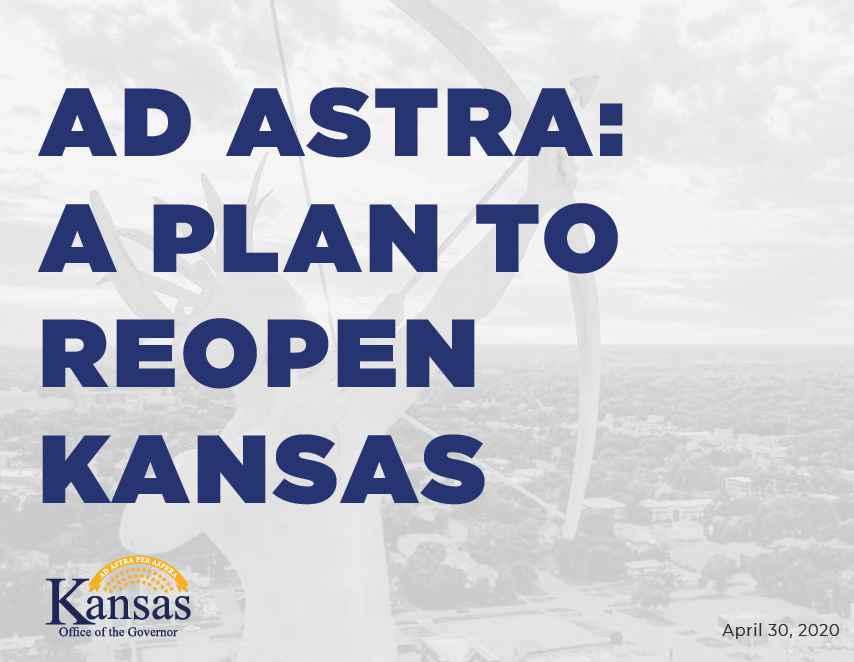Kansas Outlines Plan to Reopen from COVID Shutdown
/The state of Kansas issued its plan for a gradual reopening of the Kansas economy after the drastic lockdown imposed in response to the COVID-19 pandemic.
cover sheet from governor’s plan
“We have been through quite an ordeal these last two months,” said Governor Laura Kelly in presenting the plan on April 30. “As we prepare for the future, everyone has a responsibility to do their part in protecting their fellow Kansans. This framework is not a return to the life we knew just a few short months ago.”
The plan calls for the state-wide “Safer at Home” order to expire on May 4th, giving way to Phase I of the reopening plan. During Phase I, restaurants and libraries will be allowed to reopen, while a number of other businesses and venues, including hair salons, barbers, fitness centers, bars and nightclubs, and non-tribal casinos, will remain closed. Organized sports activities, summer camps, swimming pools, and fairs, parades and festivals will all remain off limits.
During Phase 1, the ban on public or group assemblies larger than 10 people remains, as does the encouragement to wear masks in public and maintain social distancing (no contact and 6 foot or more separation between people) when in public. Kansans will continue to be asked to remain home when sick, follow all isolation and quarantine orders issued, wash their hands regularly, and be diligent about cleaning and disinfecting surfaces.
Businesses that reopen during Phase 1 are mandated to maintain 6 feet of distance between consumers, follow industry-specific guidelines for cleaning and hygiene practices, and avoid instances in which 10 or more individuals are together in one location. Those that can tele-work should continue to do so during this phase. Those that are sick or have COVID-like symptoms must stay home.
Individual counties retain the right to impose more stringent guidelines than the state. Both Wyandotte and Johnson Counties have already announced that their stay-at-home orders will remain for an additional week.
Later phases of the reopening plan will come once the Governor determines that health and virus indicators indicate that is acceptable to do so. The Plan does not yet specify precise thresholds, but says that the factors will include evaluations of the state’s disease spread, testing rates, death rates, hospitalizations, ability of state and local public health authorities to contain outbreaks and conduct contact tracing, and availability of personal protective equipment
If all goes extremely well, Phase 2 could be reached no sooner than May 18th. During Phase 2, the list of businesses that can open expands to include community centers, swimming pools, organized sports facilities, bars and nightclubs (at 50% occupancy) and casinos. The restriction on group sizes increases to 30 individuals.
Moving on to Phase 3, which won’t happen until June 1st at the earliest, most businesses will be able to reopen, subject to the same social distancing requirements, and allowable group sizes will increase to 90 individuals. Businesses at this point are free to reduce telework and start bringing employees back to the office. Businesses may also begin to renew non-essential travel at this time.
The final stage, called “Phase Out”, which will not come any sooner than June 15th and is dependent on the state’s success in maintaining control over the virus, will reduce most remaining restrictions, though specific guidelines may be issued at that time. Local government retain the right to have more stringent measures, and all federal restrictions at that time would still be in effect
Throughout these phases, individuals with a higher risk of contracting COVID-19 are cautioned to remain at home except when conducting essential functions. In Phase 3, the guidance envisions some loosening of the self-imposed restrictions, although limiting public outings and maintaining physical distancing should still be a priority.
For more information about the state-wide plan, visit covid.ks.gov. For details in individual counties, refer to your local Public Health Department.



